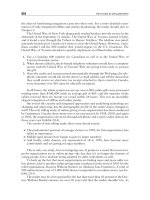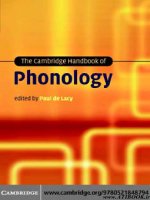The Cambridge Handbook of Creativity
Bạn đang xem bản rút gọn của tài liệu. Xem và tải ngay bản đầy đủ của tài liệu tại đây (3.25 MB, 508 trang )
This page intentionally left blank
The Cambridge Handbook of Creativity
The Cambridge Handbook of Creativity is a comprehensive scholarly handbook on creativity
from the most respected psychologists, researchers, and educators. This handbook serves as
a thorough introduction to the field of creativity and as an invaluable reference and current
source of important information. It covers such diverse topics as the brain, education, busi-
ness, and world cultures. The first section, “Basic Concepts,” is designed to introduce readers
to the history of and key concepts in the field of creativity. The next section, “Diverse
Perspectives on Creativity,” contains chapters on the many ways to approach creativity.
Several of these approaches, such as the functional, evolutionary, and neuroscientific
approaches, have been invented or greatly reconceptualized in the last decade. The third
section, “Contemporary Debates,” highlights ongoing topics that still inspire discussion.
Finally, the editors summarize and discuss important concepts from the book and look at
what lies ahead.
James C. Kaufman, PhD, is an Associate Professor of Psychology at the California State Uni-
versity at San Bernardino, where he directs the Learning Research Institute. Dr. Kaufman’s
research focuses on the nurturance, structure, and assessment of creativity. He is the author
or editor of more than 150 publications, including seventeen books either published or in
press. These books include Creativity 101 (2009), Essentials of Creativity Assessment (with
Jonathan Plucker and John Baer, 2008), and The International Handbook of Creativity (with
Robert J. Sternberg, 2006). His research has been featured on CNN, NPR, and the BBC and
in the New York Times, Los Angeles Times,andNew Yorker. Kaufman is a founding coeditor
of the official journal for the American Psychological Association’s Division 10, Psychology of
Aesthetics, Creativity, and the Arts. He also is the associate editor of Psychological Assessment
and Journal of Creative Behavior, the editor of International Journal of Creativity and Problem
Solving, and the series editor of the Psych 101 series. He received the 2003 Daniel E. Berlyne
Award from APA’s Division 10,the2008 E. Paul Torrance Award from the National Asso-
ciation for Gifted Children, and the 2009 Early Career Research Award from the Western
Psychological Association.
Robert J. Sternberg, PhD, is Provost and Senior Vice President of Oklahoma State University.
Until 2010, he was Dean of the School of Arts and Sciences and Professor of Psychology
and Education at Tufts University. He is also Honorary Professor of Psychology at the
University of Heidelberg. He was previously IBM Professor of Psychology and Education
in the Department of Psychology; Professor of Management in the School of Management;
and Director of the Center for the Psychology of Abilities, Competencies, and Expertise at
Yale. His PhD is from Stanford, and he holds 11 honorary doctorates. Sternberg was the 2003
President of the American Psychological Association and is the past President of the Eastern
Psychological Association. He is currently President of the International Association for
Cognitive Education and Psychology and President-Elect of the Federation of Associations of
Behavioral and Brain Sciences. The central focus of his research is on intelligence, creativity,
and wisdom, and he also has studied love and close relationships as well as hate. He is
the author of approximately 1,200 journal articles, book chapters, and books, and he has
received more than $20 million in government and other grants and contracts for his research,
conducted on five different continents. He has won more than two dozen awards for his
research. Sternberg has been listed in the APA Monitor on Psychology as one of the top 100
psychologists of the twentieth century and is listed by the ISI as one of its most highly cited
authors in psychology and psychiatry.
The Cambridge Handbook
of Creativity
Edited by
JAMES C. KAUFMAN
California State University, San Bernardino
ROBERT J. STERNBERG
Oklahoma State University
CAMBRIDGE UNIVERSITY PRESS
Cambridge, New York, Melbourne, Madrid, Cape Town, Singapore,
S
˜
ao Paulo, Delhi, Dubai, Tokyo, Mexico City
Cambridge University Press
32 Avenue of the Americas, New York,
NY 10013-2473, USA
www.cambridge.org
Information on this title: www.cambridge.org/9780521730259
© Cambridge University Press 2010
This publication is in copyright. Subject to statutory exception
and to the provisions of relevant collective licensing agreements,
no reproduction of any part may take place without the written
permission of Cambridge University Press.
First published 2010
Printed in the United States of America
A catalog record for this publication is available from the British Library.
Library of Congress Cataloging in Publication data
The Cambridge handbook of creativity / edited by James C. Kaufman, Robert J. Sternberg.
p. cm. – (Cambridge handbooks in psychology)
Includes bibliographical references and index.
ISBN 978-0-521-51366-1 – ISBN 978-0-521-73025-9 (pbk.)
1. Creative ability. I. Kaufman, James C. II. Sternberg, Robert J. III. Title. IV. Series.
BF408.173 2010
153.3
5 –dc22 2010000993
ISBN 978-0-521-51366-1 Hardback
ISBN 978-0-521-73025-9 Paperback
Cambridge University Press has no responsibility for the persistence or accuracy of
URLsfor
external or third-party Internet Web sites referred to in this publication and does not
guarantee that any content on such Web sites is, or will remain, accurate or appropriate.
We would like to dedicate this book to the memory of
Colin Martindale – a brilliant and prescient scholar,
supportive mentor, and valued friend.
Contents
List of Tables and Figures page ix
Contributors xi
Preface xiii
Acknowledgments xvii
SECTION I: BASIC CONCEPTS
1 Creativity Research: A Historical View 3
Mark A. Runco and Robert S. Albert
2 Theories of Creativity 20
Aaron Kozbelt, Ronald A. Beghetto, and Mark A. Runco
3 Assessment of Creativity 48
Jonathan A. Plucker and Matthew C. Makel
4 The Roles of Creativity in Society 74
Seana Moran
SECTION II: DIVERSE PERSPECTIVES ON CREATIVITY
5 Cognition and Creativity 93
Thomas B. Ward and Yuliya Kolomyts
6 The Function of Personality in Creativity: The Nature and Nurture of the
Creative Personality 113
Gregory J. Feist
7 How Does a Visual Artist Create an Artwork? 131
Paul J. Locher
vii
viii CONTENTS
8 Organizational Creativity: A Systems Approach 145
Gerard J. Puccio and John F. Cabra
9 Creativity in Highly Eminent Individuals 174
Dean Keith Simonton
10 Everyday Creativity: Process and Way of Life – Four Key Issues 189
Ruth Richards
11 The Neurobiological Foundation of Creative Cognition 216
Allison B. Kaufman, Sergey A. Kornilov, Adam S. Bristol, Mei Tan, and
Elena L. Grigorenko
12 Developmental Approaches to Creativity 233
Sandra W. Russ and Julie A. Fiorelli
13 Educational Creativity 250
Jeffrey K. Smith and Lisa F. Smith
14 Cross-Cultural Perspectives on Creativity 265
Todd Lubart
15 Evolutionary Approaches to Creativity 279
Liane Gabora and Scott Barry Kaufman
16 Functional Creativity: “Products” and the Generation of Effective Novelty 301
David Cropley and Arthur Cropley
SECTION III: CONTEMPORARY DEBATES
17 Is Creativity Domain Specific? 321
John Baer
18 The Creativity–Motivation Connection 342
Beth A. Hennessey
19 Individual and Group Creativity 366
R. Keith Sawyer
20 Creativity and Mental Illness 381
Paul J. Silvia and James C. Kaufman
21 The Relationship between Creativity and Intelligence 395
Kyung Hee Kim, Bonnie Cramond, and Joyce VanTassel-Baska
22 Divergent Thinking, Creativity, and Ideation 413
Mark A. Runco
23 Creativity in the Classroom 447
Ronald A. Beghetto
SECTION IV: CONCLUSION
24 Constraints on Creativity: Obvious and Not So Obvious 467
Robert J. Sternberg and James C. Kaufman
Index 483
List of Tables and Figures
Tables
2.1 Summary of Theories of Creativity
page 27
8.1 Comparison of Dimensions Deemed to Be Important to the Creative
Environment
152
10.1 Typology of Relations of Creativity to Problems/Pathology 199
16.1 The Core Psychological/Educational Products of the Seven Phases 312
17.1 Correlations Among Creativity Ratings 326
17.2 Partial Correlations Among Creativity Ratings 327
Figures
6.1 Functional Model of the Creative Personality
115
8.1 Creativity: A Systems Model 148
17.1 General Thematic Areas from Kaufman, Cole, and Baer (2009) 333
ix
Contributors
ROBERT S. ALBERT
Pitzer College
J
OHN BAER
Rider University
R
ONALD A. BEGHETTO
University of Oregon
A
DAM S. BRISTOL
Aquilo Partners, San Francisco
J
OHN F. CABRA
Buffalo State University of New York
B
ONNIE CRAMOND
University of Georgia
A
RTHUR CROPLEY
University of Hamburg
D
AVID CROPLEY
University of South Australia
G
REGORY J. FEIST
San Jose State University
J
ULIE A. FIORELLI
Case Western Reserve University
L
IANE GABORA
University of British Columbia
E
LENA L. GRIGORENKO
Yale University and Moscow State
University, Russia
K
YUNG HEE KIM
The College of William and Mary
B
ETH A. HENNESSEY
Wellesley College
A
LLISON B. KAUFMAN
University of California, Riverside
J
AMES C. KAUFMAN
California State University, San Bernardino
S
COTT BARRY KAUFMAN
Yale University
Y
ULIYA KOLOMYTS
University of Alabama
xi
xii CONTRIBUTORS
SERGEY A. KORNILOV
Moscow State University, Russia
A
ARON KOZBELT
Brooklyn College
P
AUL J. LOCHER
Montclair State University
T
ODD LUBART
Universit
´
e Paris Descartes
M
ATTHEW C. MAKEL
Duke University
S
EANA MORAN
Stanford University
J
ONATHAN A. PLUCKER
Indiana University
G
ERARD J. PUCCIO
Buffalo State University of New York
R
UTH RICHARDS
Saybrook Graduate School, McLean
Hospital, and Harvard Medical School
M
ARK A. RUNCO
University of Georgia
S
ANDRA W. RUSS
Case Western Reserve University
R. K
EITH SAWYER
Washington University
P
AUL J. SILVIA
University of North Carolina at
Greensboro
D
EAN KEITH SIMONTON
University of California, Davis
J
EFFREY K. SMITH
University of Otago, New Zealand
L
ISA F. SMITH
University of Otago, New Zealand
R
OBERT J. STERNBERG
Oklahoma State University
M
EI TAN
Yale University
J
OYCE VANTASSEL-BASKA
The College of William and Mary
T
HOMAS B. WARD
University of Alabama
Preface
With the world changing more rapidly than
ever before, creativity is at a historical pre-
mium. As many investors have discovered,
yesterday’s investment strategies do not nec-
essarily work anymore. As many politicians
and citizens alike have discovered, yester-
day’s ideas about ethical behavior and pro-
priety do not necessarily apply today. As
many CEOs have discovered, the competi-
tion today is quite different from at any time
in history. Printed newspapers, for example,
have to compete not only with each other,
but with their own online versions. We live
in a society where those who do not cre-
atively innovate risk failure in any of several
domains of life.
Just what is creativity? It can refer to a
person, process, place, or product. It can be
found in geniuses and in small children. It
has been studied by psychologists, educa-
tors, neuroscientists, historians, sociologists,
economists, engineers, and scholars of all
types. Legendary thinkers throughout time,
from Aristotle to Einstein, have pondered
what it means to be creative. There are
still debates, after more than six decades of
intensive research, on how to measure, uti-
lize, and improve it.
The first step to understanding creativity
is to define it. Most definitions of creative
ideas comprise three components (Kaufman
& Sternberg, 2007). First, creative ideas must
represent something different, new, or inno-
vative. Second, creative ideas are of high
quality. Third, creative ideas must also be
appropriate to the task at hand or some
redefinition of that task. Thus, a creative
response is novel, good, and relevant.
It has been more than a decade since
Robert J. Sternberg, one of the editors of
this volume, edited Cambridge’s last Hand-
book of Creativity. Since it was published in
1999, there have been more than 10,000 pub-
lished papers concerning creativity, along
with hundreds of books. More than ever,
there is a flourishing community of schol-
ars focusing on creativity. The American
Psychological Association’s Division 10,the
Society for the Psychology of Aesthetics,
Creativity, and the Arts, now sponsors an
official APA journal on this topic (Psychol-
ogy of Aesthetics, Creativity, and the Arts).
xiii
xiv PREFACE
Established journals such as the Creativ-
ity Research Journal, Journal of Creative
Behavior, Empirical Studies of the Arts,and
Imagination, Creativity, and Personality con-
tinue to publish exciting new papers. New
journals have emerged (e.g., Thinking Skills
and Creativity, International Journal of Cre-
ativity and Problem Solving). Other jour-
nals feature work on creativity in differ-
ent areas, such as gifted education (Roeper
Review and Gifted Child Quarterly) and busi-
ness (Innovation and Creativity Management,
Leadership Quarterly). Several major writ-
ten and edited works by leading scholars
have appeared in the last decade. A few
examples of such works include Dorfman,
Locher, and Martindale (2006); Piirto (2004);
Puccio, Murdock, and Mance (2006); Runco
(2007), Sawyer (2006), Simonton (2004); and
Weisberg (2006). Kaufman (2009) provides a
detailed overview of these recent works.
Structure of This Handbook
We have structured The Cambridge Hand-
book of Creativity into four parts. The first
part, which we call “Basic Concepts,” is
designed to introduce readers to the history
and key concepts in the field of creativity.
This section begins with a history of creativ-
ity research by Mark A. Runco and Robert S.
Alpert. It is followed by a thorough review
of major theories of creativity written by
Aaron Kozbelt, Ronald A. Beghetto, and
Mark A. Runco. Next, Jonathan A. Plucker
and Matthew C. Makel review creativity
assessment, followed by Seana Moran’s dis-
cussion of the role of creativity in today’s
society.
The next section is titled “Diverse Per-
spectives on Creativity.” This section con-
tains chapters on the many ways to approach
creativity. Several of these approaches, such
as functional, evolutionary, and neurosci-
entific approaches, have been invented or
greatly reconceptualized in the last decade.
We begin with Thomas B. Ward and Yuliya
Kolomyts describing the cognitive approach
to creativity, then shift to Gregory J. Feist’s
chapter on the creative personality. Paul
J. Locher writes about creativity and aes-
thetics, and Gerard J. Puccio and John
F. Cabra cover organizational approaches.
Dean Keith Simonton then discusses major
(or “Big C”) creativity, followed by Ruth
Richards on everyday (or “little c”) creativ-
ity. Neurobiological foundations of creativ-
ity are discussed by Allison B. Kaufman,
Sergey A. Kornilov, Adam S. Bristol, Mei
Tan, and Elena L. Grigorenko, while San-
dra W. Russ and Julie A. Fiorelli write
about developmental approaches to creativ-
ity. Jeffrey K. Smith and Lisa F. Smith
discuss educational perspectives on creativ-
ity, and Todd Lubart analyzes cross-cultural
research and theory. Next, Liane Gabora
and Scott Barry Kaufman highlight evolu-
tionary theories of creativity. Finally, David
Cropley and Arthur Cropley write about
functional creativity.
The third section of the book offers
essays that cover “Contemporary Debates”
in creativity – ongoing debates that still
inspire discussion. John Baer addresses the
question of whether creativity is one thing
(domain-general) or many things (domain-
specific). Beth A. Hennessey analyzes how
intrinsic motivation may affect creativity.
R. Keith Sawyer discusses the compara-
tively new area of group (as opposed to
individual) creativity. Paul J. Silvia and
James C. Kaufman highlight the contro-
versial topic of creativity and mental ill-
ness, and Kyung Hee Kim, Bonnie Cra-
mond, and Joyce VanTassel-Baska outline
the often-conflicting literature on how cre-
ativity relates to intelligence. Mark A. Runco
distinguishes between the idea of diver-
gent thinking and creativity, and Ronald A.
Beghetto concludes the section with a dis-
cussion of creativity in the classroom.
Finally, in the last section, we both sum-
marize and highlight important concepts
from the book and look to the future at what
lies ahead.
The chapters in this book discuss research
and theories from all aspects of creativity.
The authors tackle such diverse topics as the
brain, education, business, and world cul-
tures. We hope that this handbook not only
can serve as an introduction to the study of
PREFACE xv
creativity but also can represent a launch-
ing pad for more debates, discussions, and
future research.
References
Dorfman, L., Locher, P., & Martindale, C. (Eds.).
(2006). New directions in aesthetics, creativity,
and the arts (Foundations and Frontiers in Aes-
thetics). Amityville, NY: Baywood Press.
Kaufman, J. C. (2009). Creativity 101.NewYork:
Springer.
Kaufman, J. C., & Sternberg, R. J. (2007).
Resource review: Creativity. Change, 39, 55–
58.
Piirto, J. A. (2004). Understanding creativity.
Scottsdale, AZ: Great Potential Press.
Puccio, G. J., Murdock, M. C., & Mance, M.
(2006). Creative leadership: Skills that drive
change. Thousand Oaks, CA: Sage.
Runco, M. A. (2007). Creativity: Theories and
themes: Research, development, and practice.
San Diego, CA: Elsevier Academic Press.
Sawyer, R. K. (2006). Explaining creativity: The
science of human innovation. Oxford: Oxford
University Press.
Simonton, D. K. (2004). Creativity in science:
Chance, logic, genius, and zeitgeist.NewYork:
Cambridge University Press.
Weisberg,R.(2006). Creativity: Understanding
innovation in problem solving, science, invention
and the arts. Hoboken, NJ: John Wiley.
Acknowledgments
Editing this book has been a labor of love,
and it has been an honor to work with such
a distinguished and noteworthy group of
authors. We would like to thank Maria Avi-
tia, Candice Davis, Ryan Holt, Amber Lytle,
Tessy Pumaccahua, Amanda Roos, Lauren
Skidmore, Roberta Sullivan, Oshin Varta-
nian, Arielle White, and Vanessa Zarate for
their assistance in preparing the manuscript;
Simina Calin and Jeanie Lee from Cam-
bridge University Press and Phil Laughlin
and Eric Schwartz, formerly of Cambridge
University Press; and our departments and
universities for their support. James would
like to thank Allison, Jacob, Mom and Dad,
and everyone else in his family for their sup-
port and love. Bob would like to thank Karin
for her love, support, and patience while he
read and edited chapter after chapter after
chapter.
xvii









